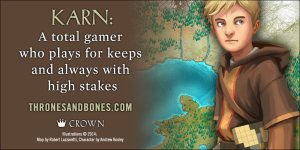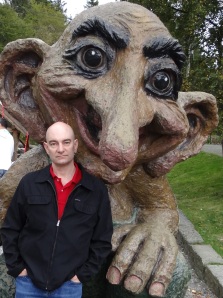The Hardest Part: Lou Anders on Frostborn
← The Exploding Spaceship Recommends Some Good UK Books for US Holiday-goersPaul Kincaid's From the Other Side, August 2014: New books from NewCon and Beccon, and two sf novels getting serious mainstream attention →
The Hardest Part: Lou Anders on Frostborn
Posted on 2014-08-25 at 14:01 by montsamu
In his ten years and counting tenure at Pyr, award-winning editor and art director Lou Anders has been on the other side of the desk from many fantastic fantasy novels and their authors, from James Enge's Blood of Ambrose to Clay and Susan Griffith's Vampire Empire and Allen Steele's Apollo's Outcasts, he's made suggestions and fought for cuts and rewrites. As he writes here, he intended to (and in fact did) approach writing a novel with a willingness to revise to sell, but something happened along the way that turned the editing process into the hardest part of seeing his debut novel, Frostborn, published. Frostborn is the first book in Anders's "Thrones and Bones" series for young readers, "a thoroughly enjoyable Viking-infused middle grade fantasy for boys and girls and their parents, with a winning combination of board gaming, frost giants, barrow mounds, and (of course!) dragons; fairly equal parts The Hobbit and (yes!) The Lion King with How to Train Your Dragon and The Black Cauldron flavoring atop a foundation of board games." (Quoting myself, reviewing the audiobook elsewhere.) I'm already indebted to Lou for his kind words about Bull Spec early on, and for giving me the time for an in-depth, at-length interview in Bull Spec #4, and I hope you're as interested here in what he has to say as I was.
By Lou Anders:
When I wrote my first manuscript, the agent I was courting put me through an intense rewrite before he would agree to take me on and another one after he did. I told him I’d do anything to get it where it needed to be, and at one point we were debating having me rewrite the entire book to take it from third person to first person.
When I wrote my second manuscript, having already put it through several rewrites, I rewrote the entire thing to alter it from a young adult to a middle grade novel at the behest of an editor who thought she would be able to pick it up if I did.
My motto was “do what it takes to sell” and don’t be precious about anything.

When I wrote my third manuscript, I finished it and said, “This one is exactly what I want it to be. Whatever it is, it came out exactly as I intended,” and I told my agent and my family that I didn’t really care what anybody else thought, this one was perfect. I wasn’t changing a word. Not a word. That was Frostborn, and it sold.
I think Frostborn went through nine drafts before it debuted in print. Let’s look at that again. The book I thought was perfect went through nine drafts. First my agent and then my editor. About fourteen thousand words were cut. One entire chapter. And a thousand little tweaks to words or phrases that cumulatively made all kinds of difference. And it is a much, much stronger manuscript as a result.
I’m really grateful for all the work that has gone into this book on the part of other people. And all the work those other people made me do. I cannot stress how valuable an experience it was nor how much the text benefitted. But I’d be lying if I said I could see this from the beginning. To my shame I was a prima donna once, near the start of the process when I sat down with the first round of edits. I think the man who has spent fourteen years editing other people’s work as an editor in the publishing field surprised himself with his resistance to being edited when it was his baby on the table. After being willing to change everything about manuscripts one and two, I was suddenly—surprisingly—precious about manuscript three. All my fear and reluctance peaked. I was terrified—terrified—to cut into my “masterpiece” and alter it.

All that vanished in a puff of smoke the first time I read through the edited manuscript and saw how much stronger, clearer, and closer to my intent it actually was than what came before. Then my wife read through it and couldn’t tell where the cuts were, though she felt the whole thing flowed faster and was better paced. Everything that had been in the book before is still there (barring one chapter). The prose hadn’t been savaged, it had been refined, rough stone polished diamond bright. I was in awe.
The hardest part was learning to trust that edit. Or rather, the hardest part was making those first cuts. Once I saw the results, it was easy to trust on the basis of the results. The hardest part isn’t hard anymore. It’s become one of the most rewarding.
------------
Lou Anders's research on Norse mythology while writing Frostborn turned into a love affair with Viking culture and a first visit to Norway. He hopes the series will appeal to boys and girls equally. Anders is the recipient of a Hugo Award for editing and a Chesley Award for art direction. He has published over 500 articles and stories on science fiction and fantasy television and literature. Frostborn, which Publishers Weekly described as “thoroughly enjoyable” (starred review), is his first middle grade novel. A prolific speaker, Anders regularly attends writing conventions around the country. He and his family reside in Birmingham, Alabama. You can visit Anders online at louanders.com and ThronesandBones.com, on Facebook, and on Twitter at @ThronesandBones.



